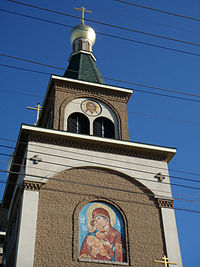- Demographics of Erie, Pennsylvania
-
Historical populations Census Pop. %± 1880 27,237 — 1890 40,634 49.2% 1900 52,733 29.8% 1910 66,525 26.2% 1920 93,372 40.4% 1930 115,967 24.2% 1940 116,955 0.9% 1950 130,803 11.8% 1960 138,440 5.8% 1970 129,231 −6.7% 1980 119,123 −7.8% 1990 108,718 −8.7% 2000 103,717 −4.6% Population 1880 - 1970.[1]
Population 1980-2000[2]As of the census[3] of 2000, there were 103,717 people, 40,938 households, and 24,480 families residing in Erie, Pennsylvania. The population density was 1,823.6 km² (4,722.9 mi²). There were 44,971 housing units at an average density of 790.7 km² (2,047.8 mi²). The racial makeup of the city was 80.6% White, 14.2% African American, less than 1% each of Native American, Asian, and Pacific Islander, respectively. 1.9% from other races and 2.3% from two or more races. Hispanic or Latino of any race were 4.4% of the population. Erie has long been declining in population due to the departure of many businesses and factories.[4] The city has lost over 40,000 people since the early 1970s; allowing Allentown to claim the 3rd largest spot.
There were 40,938 households out of which 29.2% had children under the age of 18 living with them, 38.2% were married couples living together, 16.8% had a female householder with no husband present, and 40.2% were non-families. Thirty-three and four tenths percent of all households were made up of individuals and 13.3% had someone living alone who was 65 years of age or older. The average household size was 2.39 and the average family size was 3.08.
In the city the population was spread out with 25.4% under the age of 18, 11.6% from 18 to 24, 28.5% from 25 to 44, 19.2% from 45 to 64, and 15.4% who were 65 years of age or older. The median age was 34 years. For every 100 females there were 90.8 males. For every 100 females age 18 and over, there were 86.2 males.
The median income for a household in the city was $28,387, and the median income for a family was $36,446. Males had a median income of $30,714 versus $21,828 for females. The per capita income for the city was $14,972. About 13.8% of families and 18.8% of the population were below the poverty line, including 27.0% of those under age 18 and 10.3% of those age 65 or over.
The major ethnic groups of the City of Erie are roughly broken down into 24% German, 14% Irish, 14% Polish, 13% Italian, 6% English, 2% Swedish, 2% French, 2% Russian, and the remaining 23% make up the ‘other’ category.[5]
Since the mid 1990s, the International Institute of Erie (IIE), founded in 1919, has helped with the resettlement of refugees from Bosnia, Eritrea, Ghana, Iraq, Kosovo, Liberia, Somalia, Sudan, the former Soviet Union, and Vietnam.[6]
In the early 20th century, Erie had a significant Russian immigrant community, many of whom worked in the shipbuilding plants along the bayfront. Unusual for a Great Lakes city, a substantial number of these Russian immigrants were Old Believers. Even today, the gold-domed Church of the Nativity,[7] on the bayfront near the former heart of the Russian community, is an Old Believer church, home to famed Icon painter Fr. Theodore Jurewicz.[8] Bishop Daniel of Erie,of the Russian Orthodox Church Outside Russia, is based in Erie and is the Vicar President of the Synod of Bishops for the Old Believers.[9]
Erie has a Jewish community that is over one hundred fifty years old. Temple Anshe Hesed, a member of the Union for Reform Judaism, is served by its spiritual leader, Rabbi John L. Bush.[10] Erie is home to the Roman Catholic Diocese of Erie, covering 13 counties (9,936 mi²- the largest in the state). Its diocesan seat is the Saint Peter Cathedral in Erie, which has a 265 ft central tower flanked by two 150 ft towers. It is among the tallest churches in the U.S and was constructed in 1873.
According to the Association of Religion Date Archives,[11] Erie County had a total 2000 population of 280,843 persons, of which 103,333 claimed affiliation with the Catholic Church, 40,301 with mainline Protestant houses of worship, and 12,980 with evangelical Protestant churches.
References
- ^ "Population of the 100 largest cities 1790-1990". The United States Census Bureau. http://www.census.gov/population/www/documentation/twps0027.html. Retrieved 2007-05-21.
- ^ "1980-1990 Population of Places With 100,000 or More Inhabitants". The United States Census Bureau. http://www.census.gov/population/censusdata/c1008090pc.txt. Retrieved 2007-05-21.
- ^ "American FactFinder". United States Census Bureau. http://factfinder.census.gov. Retrieved 2008-01-31.
- ^ "Erie Population Profile". City-data.com. http://www.city-data.com/us-cities/The-Northeast/Erie-Population-Profile.html. Retrieved 2007-06-28.
- ^ "Erie Social and Demographic Information". helloerie.com. http://www.helloerie.com/Social.cfm. Retrieved 2007-05-21.
- ^ "International Institute of Erie–Home". International Institute of Erie. http://www.interinsterie.org. Retrieved 2007-06-15.
- ^ "Church of the Nativity". http://www.churchofthenativity.net. Retrieved 2007-05-25.
- ^ "Russian Orthodox Bishops". Russian Orthodox Outside Russia. http://www.russianorthodoxchurch.ws/english/pages/firsttier/diocesesbishops.html. Retrieved 2007-05-26.
- ^ "Daniel Alexandrow on Orthodox Wiki". http://www.orthodoxwiki.org/Daniel_(Alexandrow)_of_Erie/. Retrieved 2007-05-26.
- ^ "Tah Erie". http://www.taherie.org/. Retrieved 2007-05-26.
- ^ The ARDA Database has no precise figures on the membership of African American churches, so it provides an estimate of 25,000 members. The two Russian orthodox churches list no membership numbers. The Salvation Army lists over 4,000 members. Jews were under a thousand, while Quakers showed no membership.[1] Retrieved on June 1, 2007.
Categories:
Wikimedia Foundation. 2010.


